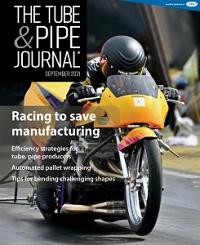- FMA
- The Fabricator
- FABTECH
- Canadian Metalworking
Categories
- Additive Manufacturing
- Aluminum Welding
- Arc Welding
- Assembly and Joining
- Automation and Robotics
- Bending and Forming
- Consumables
- Cutting and Weld Prep
- Electric Vehicles
- En Español
- Finishing
- Hydroforming
- Laser Cutting
- Laser Welding
- Machining
- Manufacturing Software
- Materials Handling
- Metals/Materials
- Oxyfuel Cutting
- Plasma Cutting
- Power Tools
- Punching and Other Holemaking
- Roll Forming
- Safety
- Sawing
- Shearing
- Shop Management
- Testing and Measuring
- Tube and Pipe Fabrication
- Tube and Pipe Production
- Waterjet Cutting
Industry Directory
Webcasts
Podcasts
FAB 40
Advertise
Subscribe
Account Login
Search
New motorcycle racing class is reviving sport, interest in fabrication skills
How the 4.60 Index Pro Mod is helping draw younger people into manufacturing
- By Eric Lundin
- September 7, 2021
- Article
- Tube and Pipe Fabrication

Chase Van Sant prepares for a race. Bruce Van Sant noted that the 4.60 class of racing is not quite as hard on the motorcycles as the old Pro Mod series was. To be competitive in the heyday of the Pro Mod series, the motorcycle would hit a top speed of nearly 200 miles per hour over a quarter mile. Racing the same motorcycle over half the distance to hit an ET of 4.60 is still exciting and extremely competitive, but it’s not as hard on the engine and the transmission, so repairs and rebuilds are less frequent. “When I was racing Pro Mod, I was pushing the motorcycle right to the edge, every time,” Bruce said. Nearly every race was followed by a teardown. David Edelstein
People who enjoy motorcycle racing probably remember the old Pro Mod class. Competing in a racing series organized by AMA/Prostar, this class of motorcycles was either modified or custom-built for drag racing in quarter-mile contests. One such bike was designed and built from scratch back in 1996. The designers and fabricators were Bruce Van Sant and Rusty Kramer, two hobby metalworkers and racing enthusiasts.
Powered by a highly modified Suzuki GS 1100, it developed about 225 HP on its own. A nitrous oxide system added another 250 HP. The racing team consisted of two Van Sant brothers, Bruce and Craig, and a family friend, Alan Geetings. They competed for several years in the late 1990s at tracks big and small throughout the Midwest and southern states.
Driven by Bruce, it went much faster than most of us would care to drive in any vehicle under any circumstances, accelerating from a standstill to 60 MPH in about 1 second and 0 to 100 MPH in 2.10 seconds. Over a quarter mile, it would pass the halfway mark at around 4.5 seconds, moving at about 170 MPH, and finish the race at just under 7 seconds at 195 MPH.
The chassis was a marvel of workmanship. Van Sant and Kramer used an I-beam for a reference and used it to locate the three main components: the engine, rear axle, and steering neck. With these three components oriented, leveled, and aligned, they created custom fixtures to secure every length of tubing that would become the motorcycle’s frame.
It was a huge task—just planning the fixtures was a huge undertaking—but it really wasn’t anything foreign to either of them. Kramer had been racing an alcohol-fueled dragster for years (Bruce was the crew chief) and the Van Sants had been involved in automobile racing since their oldest brother, Jeff, had started racing a ’57 Chevy many years earlier. Perhaps more critical was the Van Sants’ background. The brothers grew up on a family farm in central Iowa, fertile ground for growing corn and learning how to use tools and machines, how to find practical solutions to vexing problems, and often how to improvise.
The Van Sants have additional credentials. Craig knew a thing or two about bending tube, having left the family farm as adulthood loomed to pursue a career on his own. A few years repairing machines, specifically hydraulic tube benders, led to his founding Advanced Fabricating Machinery, Kingston, N.H., a company that specializes in tube fabrication machines. Bruce founded Trick Tools in Pella, Iowa, a retailer that carries an inventory of 15,000 items for hobby and professional fabricators alike. He managed to assemble a team in which every single person at the company has a background in metal fabrication, whether through previous work experience or through a hobby like racing. Both have spent their lives around tools and machines more than anything else.
When the motorcycle was featured on the cover of the October-November 2003 issue of
Little did they know that within a few years, they would take a longer break from racing.
The Future of This Motorcycle Class
“Pro Mod was a good series for quite a few years,” Bruce said. “Prostar held many of its events at large, world-class venues and got a lot of participation from the racing community.” Some of the international tracks had grandstands that held 50,000 to 60,000 people, Bruce said.
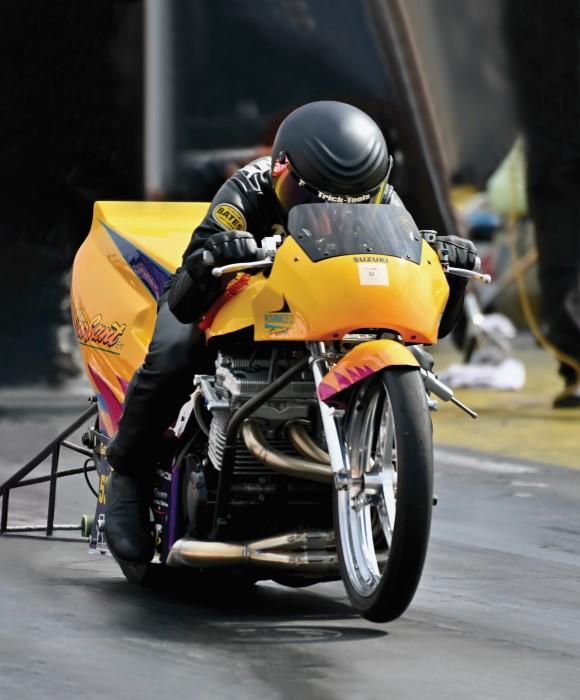
After several years in storage, Bruce Van Sant’s highly customized Suzuki is back on the racing circuit, driven by Bruce’s son Chase. David Edelstein
However, racing can be a tough business. Racing organizations come and go and eventually Prostar folded. Around 2010 another sanctioning body, the American Drag Racing League, picked up the Pro Mod class and eliminated many of the rules. This fueled new growth and performance in the class for a time, but eventually the costs of racing Pro Mod grew to a point where it became prohibitive for many to participate.
“NASCAR has rules that restrict what the teams can do to prevent the sport from getting too expensive,” Craig explained. Prostar did as well, and while faster races are more exciting, dwindling participation doesn’t bring out the fans. The Van Sant team’s last full season was in 2000, and it raced only occasionally for about 15 years after that.
Racing enthusiasts know that races for motorcycles and automobiles are organized in a handful of ways and that going as fast as possible isn’t the only format. Bracket racing, popular in auto racing, lets each racer determine his likely elapsed time (ET) in practice runs and allows two vehicles with different top ends to compete. If Racer A estimates an ET of 12 seconds and Racer B estimates 11 seconds, they get green lights one second apart and—if all goes well—cross the finish line at about the same time. Racers are disqualified if they break out (finish with an ET lower than the dialed-in time). The winner isn’t the fastest but the most consistent.
A new motorcycle racing class devised around 2015 uses a similar system, but with a single ET for every racer. Known as the 4.60 index, it limits every participant to 4.60 seconds over a track length of 1/8 mile. This is intended to keep the sport competitive. After investing in the motorcycle; adding a nitrous oxide system; and programming the onboard computer that governs the fuel delivery system, the nitrous system, and other variables, the team tries to get within a few hundredths of a second of 4.60. After that, the team can stop upgrading the motorcycle and focus on racing.
Sanctioned by a few organizations, the 4.60 class gave the sport a big boost, Bruce said, and the Van Sant team wasn’t the only team that welcomed a chance to start over. Many, many other teams brought their old bikes out, overhauled them, and started racing again. The rules were about the same as those for the Pro Mod class of 20 years ago, so the bikes didn’t need any modifications.
In part, it was like a reunion of old friends and acquaintances. It also was time to see what skill level the latest drivers—the sons and daughters of the previous generation—brought to the track. For the Van Sant team, this meant watching Bruce’s son, Chase, pilot the rocket down the track. And they have to bring a lot of skill. Many races are won and lost by just a few thousandths of a second. At 150 miles per hour, one beats the other by a difference of less than 3 in.
The Future of Manufacturing
As business owners who need employees savvy in technology, the Van Sants understand the needs of the industry. They understand that now, more than ever, the manufacturing industry must find more ways to introduce more young people to the skills manufacturers require.
“Racing might be a good way to pull more people into manufacturing,” Craig said. “It really generates an interest in learning.”
Bruce agrees. "You learn a lot about the metalworking trade when you're involved with racing," he said back in 2003. And the sport expands on that knowledge base. Making a motorcycle go fast is a practical education in electronic, hydraulic, and mechanical systems.
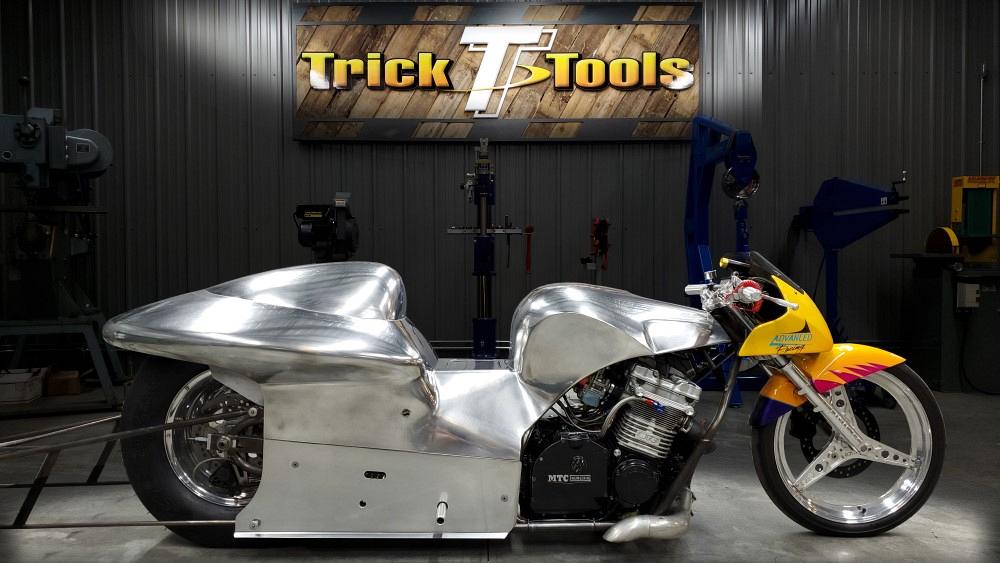
To demonstrate some of the many possibilities in metal fabrication, the team at Trick Tools created a large aluminum shroud that covers about 75% of the motorcycle. The ability of aluminum to stretch and form varies considerably and depends on the specific alloy and temper. Alloy 6061 can stretch as little as 8% and as much as 30% depending on how it’s heat treated. A benchmark material, SAE 1010 carbon steel, elongates about 20 percent. Trick Tools
It also prepares a person mentally and physically.
“There’s no instruction manual for racing,” Craig said. “You just have to figure it out.” That goes for getting started and working through problems and setbacks to improve the motorcycle’s performance. It also means tearing down engines and transmissions. Frequently.
“You have to love the work or you’re not going to last,” he said.
Vocational schools and courses that immerse students in science, technology, engineering, and mathematics (STEM) are a necessity, but the Van Sants know that avenues are needed to help lead students to such programs. Growing up on a farm, they were immersed in all things mechanical, so in their view, it starts at home.
It was an article of faith for decades that the people who ran fabrication shops and most other manufacturing plants would love to see a farm kid show up looking for work. They arrived ready to work hard and knowledgeable about tools and machines. Every farm kid grew up turning wrenches to do repairs, straightening something that was bent and tacking it down with a weld; occasionally making a part from scratch; and doing everything else necessary to coax a balky, stalled, or jammed machine back to life. It’s an apprenticeship like no other.
Small family farms are all but gone, but learning how things work can happen in any family. It has to start with the parents, Craig said.
It can start with toys that promote learning, like LEGO building sets and erector sets. They’re far more advanced than they were a generation (or two) ago, so they’re more interesting. Many come with motors and other actuators.
LEGO has kept up with the times. Its MINDSTORMS series is a system for building programmable robots with many capabilities, and from there it’s a short walk to the garage or the basement where the real fun begins.
To outfit a shop for a youngster, a small investment, say $3,000, might be enough for a good start. Manual brakes that handle sheet up to 16 ga. are available for less than $250, as are manual tubing benders that handle materials up to 1 in. diameter, manual shears that cut steel up to 1/8 in., and beefy mechanic’s vises. If a garage workbench already has a sturdy vise, it might be a matter of adding one machine, a combination brake, shear, and roll bender for about $1,000. Add another $500 in assorted hand tools and accessories for clamping and measuring, and the shop is ready to go. For families that aren’t steeped in metal fabrication, it doesn’t have to be difficult. Trick Tools has a fabrication starter kit for $2,000, and the company has a financing option. Compared to the cost of housing a family and educating the children, this is an extremely inexpensive way to prepare the kids for adulthood.
“We need to get back to making things,” Craig said. “This has become a buy-it-and-throw-it-away society. This isn’t just my opinion—everyone I talk to says this.”
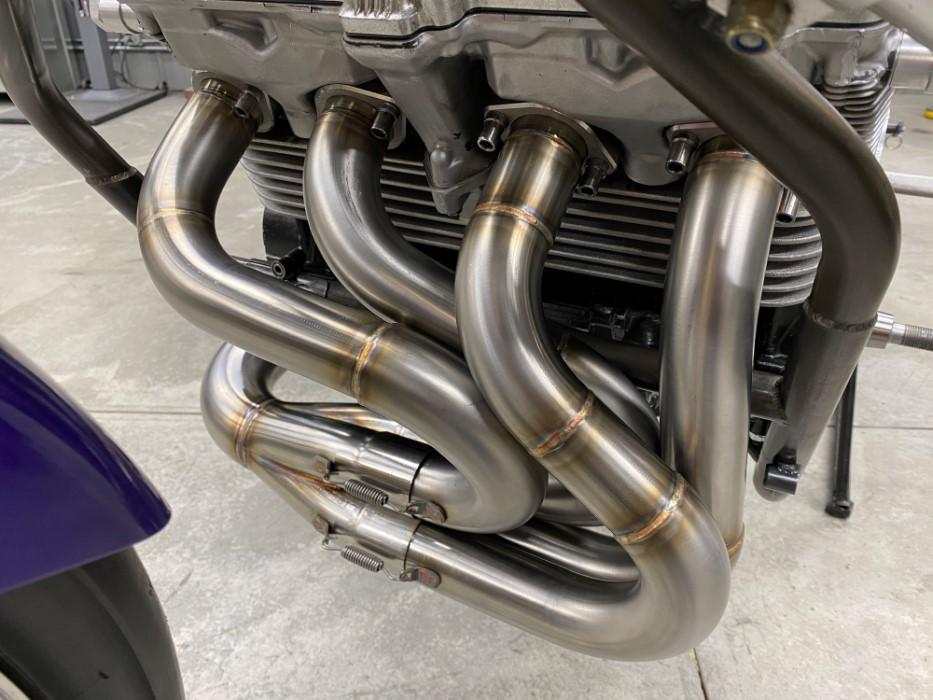
The rules for building a motorcycle to race in the 4.60 index class are very similar to those of the old Pro Mod class, so Van Sant’s motorcycle didn’t require any modifications. However, after hundreds of races over 20 years or so, the exhaust header was due for a replacement. Van Sant opted to rely more on welding than bending, joining purchased bends. Trick Tools
Craig’s line of work doesn’t lend itself too well to young people and hobby fabricators, but Bruce does his part when he can. During the height of the COVID-19 pandemic, he organized a demonstration of some processes by Zoom for the benefit of local high school students. The message: If you can think of it, there’s a way to build it. His company also dedicates quite a bit of time to developing educational videos that appear at its YouTube channel.
Craig’s influence worked out well for his family. He recently left Advanced Fabricating Machinery to start a U.S. location for German equipment manufacturer transfluid, turning Advanced over to his son.
Two of Bruce’s sons took to racing and enjoyed several years of racing junior dragsters, and Chase progressed from there. Bruce thought that Chase displayed quite a bit of mechanical aptitude at a pretty young age.
“He asked about getting out an old minibike and riding it,” Bruce said. He had the typical parent’s multidimensional dilemma, trying to figure out the best use of his time as a breadwinner, husband, and father of three. He also understood that coaxing a little ingenuity from a bright child isn’t all that difficult.
“If you can get it running, you can ride it as much as you want,” Bruce said. Of course, he figured he’d probably help Chase with the project later, but this ploy would buy Bruce some time.
“About 45 minutes later I heard the engine start,” he said.
The Future of the 4.60 Index Class
Is the 4.60 class going to remain as popular as it is currently? Maybe, maybe not. More hardware and software are creeping into this class, and it’s probably going to be more expensive as time goes on.
Sensors, software, and driver assistance features crept into Formula 1, although in the 4.60 class of motorcycle racing, it’s on a much (much, much) smaller scale. In Formula 1, active suspension, traction control, and antilock brakes were used but eventually banned because each new innovation chipped away at the skills that make racing what it is, such as track smarts, decision-making, reflexes, and coordination. So, a device that senses that the wheels are rotating at different speeds—which implies losing traction—and reduces the throttle helps by reducing the likelihood of a crash (big benefit), but it also reduces the driver’s influence over the outcome of the race (big drawback).
The 4.60 series isn’t there, but it’s moving in that direction. In the 1990s Pro Mod was very simple. It was common to use an onboard computer to gather data to analyze each race, and a fuel control system was necessary. Too much fuel at the start would make the rear tire spin too fast off the line, producing a lot of rancid rubber smoke and not much acceleration. In the case of Van Sant’s motorcycle in the current class, getting close to 4.60 seconds is a matter of starting with just 20% to 30% of the fuel system’s capacity at the start and ramping up quickly throughout the rest of the race. Preparing for each race is a matter of assessing the track condition, taking into account the ambient temperature and a few other day-to-day factors, and dialing it in as close as possible in the practice runs.
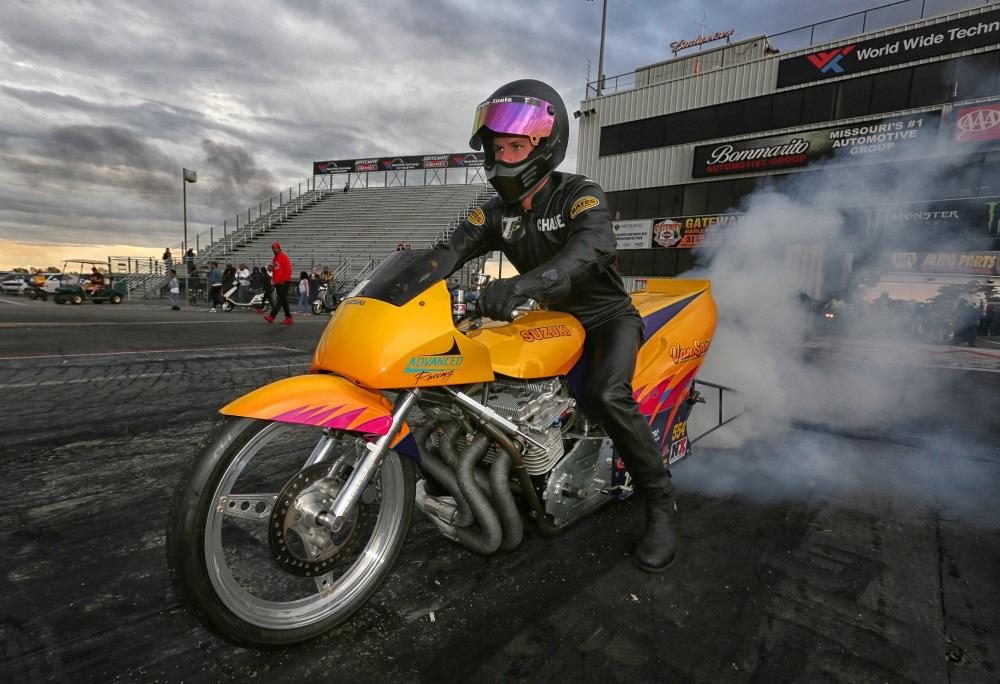
Driven by Chase Van Sant in the 4.60 index class, the 25-year-old Suzuki is essentially the same as it was when Bruce Van Sant raced it in the Pro Mod series. The new racing series is half the distance and the top speed is about 40 MPH less than the motorcycle achieved in the Pro Mod days, so it takes less intensive maintenance than it used to. Another difference? Bruce admits that Chase is a bit quicker off the line. Tim Hailey, eatmyink.com
But this class is going further than that now. Bruce recalled a recent race weekend in which the first 16 motorcycles out of the 50 or so that competed came in right at 4.60 seconds.
“They use sensors, software, and control systems that measure wheel rotation and other factors to determine how far the motorcycle has traveled, compare that to the time that has elapsed since the race started, and make adjustments to the fuel delivery to bring the motorcycle in at 4.60,” he said.
Those systems aren’t perfect, bringing in some riders several hundredths of a second over, and the Van Sant team still wins frequently. They still use the old-school method, doing a few practice runs and relying on Chase to do everything right. In the abbreviated 2020 season, the team won three of the five events in which it competed and secured championships in two different sanctioning bodies.
“It’s gratifying to know that we can beat those guys the old way,” Bruce said.
About the Author

Eric Lundin
2135 Point Blvd
Elgin, IL 60123
815-227-8262
Eric Lundin worked on The Tube & Pipe Journal from 2000 to 2022.
About the Publication
Related Companies
subscribe now

The Tube and Pipe Journal became the first magazine dedicated to serving the metal tube and pipe industry in 1990. Today, it remains the only North American publication devoted to this industry, and it has become the most trusted source of information for tube and pipe professionals.
start your free subscription- Stay connected from anywhere

Easily access valuable industry resources now with full access to the digital edition of The Fabricator.

Easily access valuable industry resources now with full access to the digital edition of The Welder.

Easily access valuable industry resources now with full access to the digital edition of The Tube and Pipe Journal.
- Podcasting
- Podcast:
- The Fabricator Podcast
- Published:
- 04/16/2024
- Running Time:
- 63:29
In this episode of The Fabricator Podcast, Caleb Chamberlain, co-founder and CEO of OSH Cut, discusses his company’s...
- Trending Articles
Team Industries names director of advanced technology and manufacturing

3D laser tube cutting system available in 3, 4, or 5 kW

Corrosion-inhibiting coating can be peeled off after use

Zekelman Industries to invest $120 million in Arkansas expansion

Brushless copper tubing cutter adjusts to ODs up to 2-1/8 in.

- Industry Events
16th Annual Safety Conference
- April 30 - May 1, 2024
- Elgin,
Pipe and Tube Conference
- May 21 - 22, 2024
- Omaha, NE
World-Class Roll Forming Workshop
- June 5 - 6, 2024
- Louisville, KY
Advanced Laser Application Workshop
- June 25 - 27, 2024
- Novi, MI
























